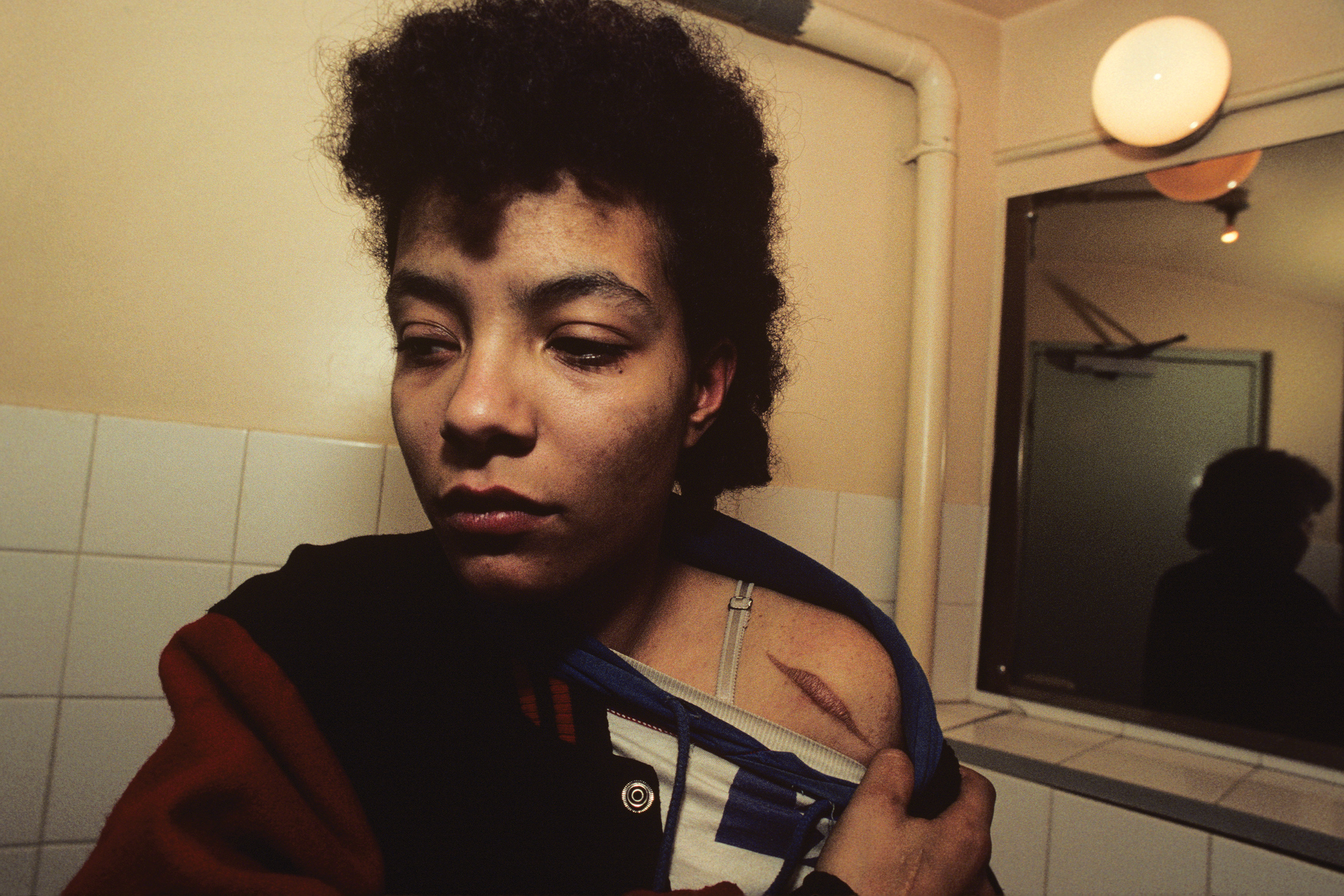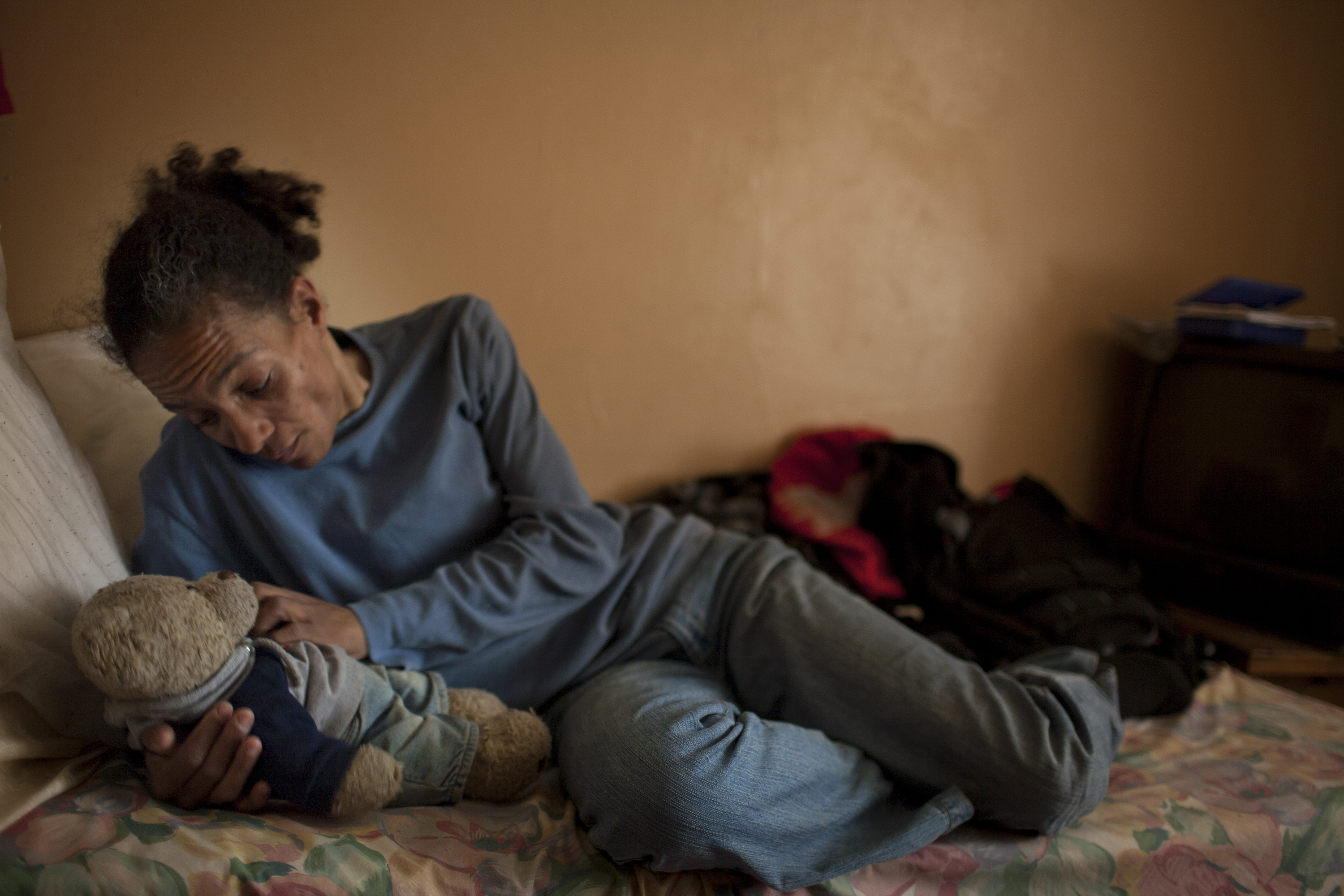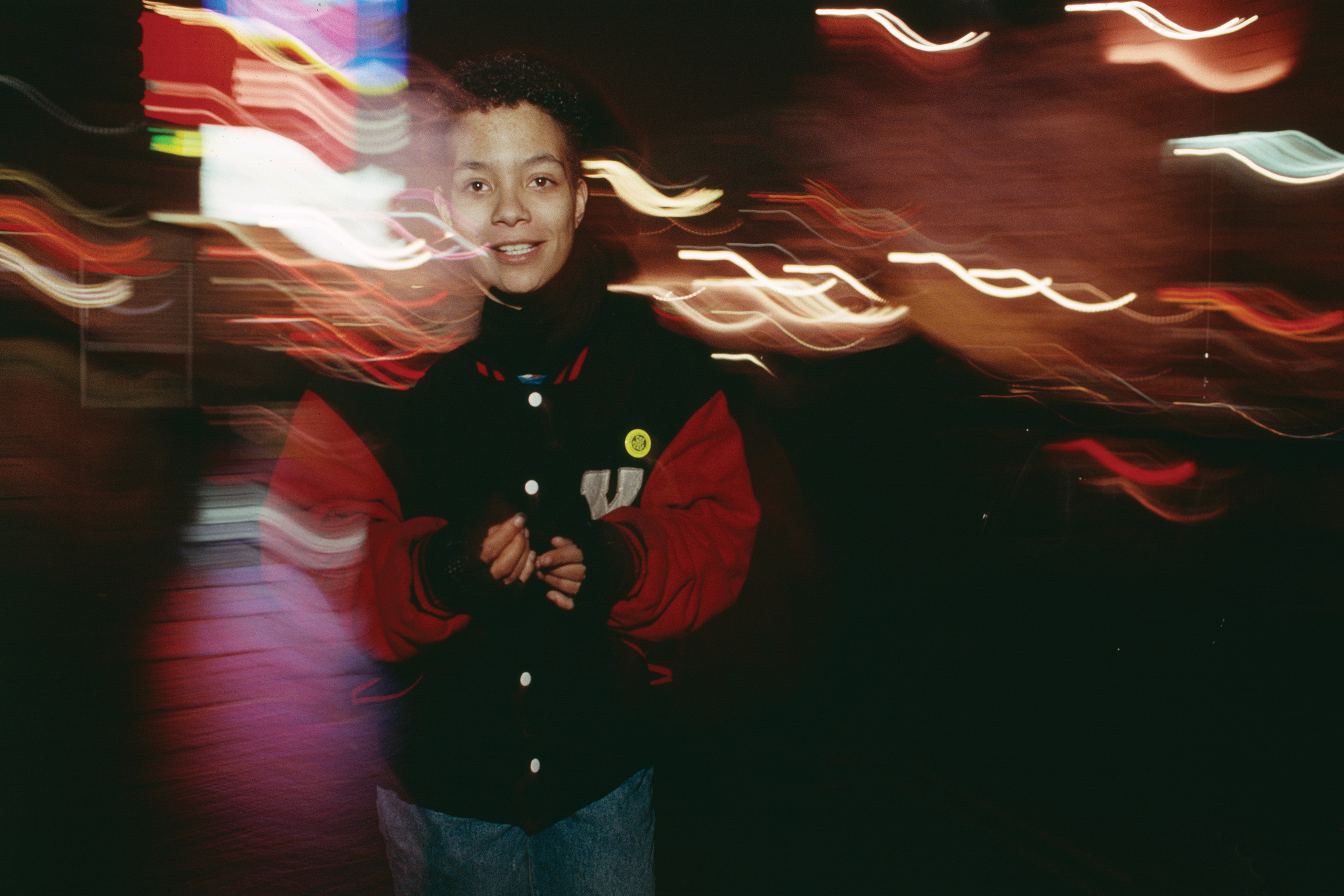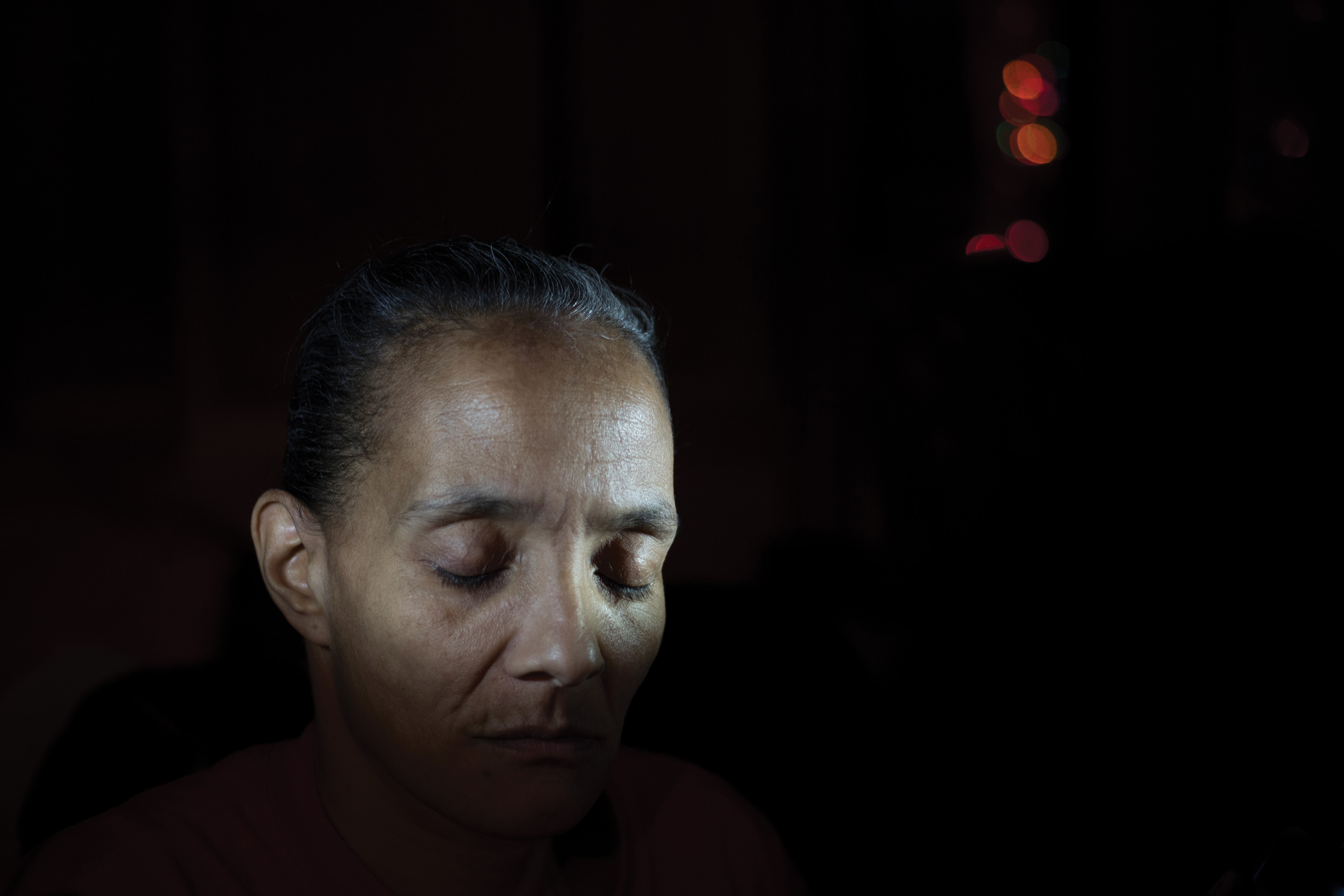
(Photo: McNair Evans)
In the late fall of 1990, I went to London intending to photograph the legacy of the Margaret Thatcher era. At the time, London’s West End was filled with hundreds if not thousands of street kids, runaways and castoffs, many of them cut loose as a result of Thatcher’s neoliberal economic policies. At night I wandered the streets of Soho and the Strand. One evening, I saw a girl pounding on a large blue door outside the Centrepoint hostel. She had a cigarette in one hand and headphones in her ears. She asked me where I was from, and when I said New York City her face lit up. Her name was Cathy.
I photographed her over several weeks as she panhandled for change, slept in car parks, chatted with social workers, smoked crack, and hustled with her street mates. Cathy would share fragments of stories about a nefarious gang that operated out of London’s Soho clubs. They were pimps, pushers, pornographers, traffickers, forgers, and killers. A black man named Mark was at the center of the violence, along with Sid, an older white man who drove a silver Mercedes. She said they owned the police. She was often afraid, and one night she showed me scars from knife wounds.


Before I headed back to New York I gave her my phone number and address, and promised to stay in touch. Cathy wrote me sporadically and phoned collect every now and then. Six months later, in the spring of 1991, she announced that she had won a television music contest and would use the money to visit New York. I said she could stay at my apartment for a few days.
When she arrived, I introduced her to my boyfriend, Carmine, and we gave her the nickname Queenie because of her English accent. In return, she called us Peasants. I showed her around New York, and took her swimming in the ocean out on Long Island. She slept on a cot in my tiny Manhattan apartment, and, one morning, while she slept, I saw her nightmares. She moaned, crunched up in a fetal position, cried, and held herself between her legs.
The next day she had a flashback. With her hands, she started feeling her way around the room, trying to escape. She seemed to have no perception of where she was or who I was. I feared she might run out the door or crash through a window. I tried to talk her down by saying she was safe and calling out her name. After 15 minutes, her eyes rolled back and she blinked as though she had awoken from a trance. She whimpered and then apologized in embarrassment. I was terrified.
The next day, we talked about her needing to get help, and decided that she should go back to England. I drove her to Kennedy Airport.
We stayed in touch, and in the fall of 1993 she returned to New York, this time with a friend named Sara. I let them stay in my place for a few weeks, giving them odd jobs, trying to keep them occupied, but eventually I had to ask them to leave because they were smoking crack.


Sara soon returned to England but Cathy remained in New York, afraid for her life if she went back. She had stolen a pornographic video that directly implicated her perpetrators and stashed it in a secret place somewhere in London. She alerted police, and advocates were helping her to out her abusers, who then got wind of her efforts. In the summer of 1993, while she was at Lorne House, a drug rehabilitation facility in East London, they had kidnapped and raped her and left threatening phone messages. A Scotland Yard officer suggested she leave England, and, in an act of remarkable kindness, gave her a few hundred pounds to flee.
In New York she became a ward of the state, and went by the name Kimberly Stevens. She received help from social service agencies as well as residential psychiatric treatment centers. Through all of this, I was her emergency contact and de facto next of kin. I met with therapists, brought her to hospitals, helped explain her story. I recall one visit to St. Luke’s hospital, where Kim was on suicide watch. A nurse stayed by her side as she moved around the locked unit. I was surprised at how peaceful and airy the floor was, with pale-colored walls and large windows. There were all sorts of people there, among them a businesswoman and a Columbia University student. In that room it didn’t matter whether you were an executive or a homeless woman. Everyone was aiming for equilibrium.
For a time, Kim lived in a group home on Staten Island, and then with a loving foster family, but frequent flashbacks prevented her from attending school, and so she was eventually removed. She would ask, half-joking, if I would adopt her.
She occasionally hooked up with boyfriends who were alternately caring and abusive. To this day, she says she cannot remember one positive sexual experience. When asked about sex, she simply says, “I hate it.”
Sometimes we would talk every day or week; sometimes we would go for months without speaking, which made me nervous and afraid she was dead or in jail. She usually called when she was in trouble, which inevitably coincided with my photography assignments. I would get off an airplane to messages from Kim, or phone calls in which she sounded overwrought, frustrated, or hysterical.


Over the years, the crises and suicide attempts took their toll on me. The magnitude of her illness and her needs at times made me resentful, and then guilty when I felt uncaring. I imagine these emotions are familiar to millions of people who have a loved one suffering from mental illness and addiction and the roller-coaster swings of hope and despair. But I held on to the knowledge, as did so many of her caregivers, that, at her core, Kim was a brilliant and creative spirit, a talented artist and musician, a kind and generous person with a remarkable sense of humor who possessed deep insight and who definitely deserved a better life.
Much of Kim’s therapy involved telling her story, which both frightened and empowered her. In one of her stronger periods, she typed out and handwrote scores of pages detailing her life, with careful descriptions of gruesome events, including those that she revisited during her flashbacks. She drew detailed pictures. She wrote poems, painted cards, wrote me letters, and dreamed of publishing a book.
But just as she would reach a new milestone, something would stop her and pull her back and she would come crashing down, or she would have a flashback and staff would get scared and want to lock her up. To this day she seems to struggle with feeling worthy enough to enjoy life.
The year 2007 marked a turning point. Kim was living in Harlem. Her health was deteriorating from HIV and chronic crack use. A police drug unit arrested her on a minor drug charge and she was sent to Rikers Island, New York City’s notoriously brutal jail. Desperate to leave Rikers, she accepted a misdemeanor plea in return for placement in a drug rehab center, but months ground on while authorities searched for a vacancy. Kim phoned every night around 7 p.m., crying.
While in Rikers, Kim twice tried to kill herself. She broke a light fixture for the glass sliver. She braided a noose with pieces of a paper gown strengthened with her own hair, and was sent to the prison hospital, where I saw her chained to the bed. During this time I learned firsthand the daily reality of New York City’s criminal justice system, the consequences of stop-and-frisk, and the violence of the war on drugs, which was really a war on poor black and brown people.


Eventually, a Manhattan court judge agreed to release Kim to my custody, and soon after directed her to a Bronx halfway house, where, she told me, she was raped by another resident.
Kim’s release from Rikers required that she provide urine samples at Manhattan’s Treatment Court to prove that she was drug-free. An official stood by to observe her while she urinated, which triggered traumatic memories. We would sit in that airless room for hours, she drinking water, trying to gather courage; me pacing in circles; both of us begging the official to swab her mouth instead.
Her first apartment was a tiny room with a shared bathroom at a harm-reduction facility for HIV patients on West 36th Street. Kim was rail-thin, her teeth rotted out. At one point her T cells dropped below 50. Still, she seemed happy to have a little place, and she put pictures of my daughter and me on her wall along with notes, reminders, and her writings.
One evening at sunset, we wandered through Central Park admiring the trees. In moments of despair, Kim had considered ending her life by hanging herself there. Each time she talked herself out of it. Children might see her and get frightened. We ended up at the 110th Street pond. The sky was pink and dreamy. Kim told me that she imagined having a boat and paddling across the water. I could imagine that for her too. As we left the park and walked along 110th Street in Harlem, a man asked Kim if she wanted crack. Another asked her for a blowjob.
This photographic project aims to tell a story about loneliness and love, of hurt and resilience, of friendship, courage, and a will to live. All too often, despite clear indications of major sexual abuse and trauma, survivors are called to task while perpetrators, because of the rules of evidence and the fear instilled in victims, remain free to continue to profit from their violent schemes. The piece of the picture that is often missing is, What happens after the violence? What happens to the rest of the life?


A version of this story originally appeared in the September/October 2018 issue of Pacific Standard. Subscribe now to support independent journalism in the public interest.





